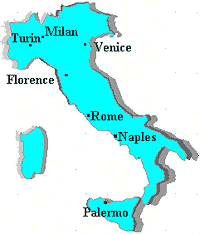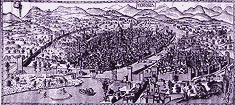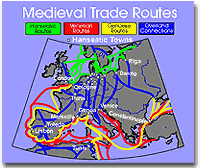| HOME |
Why Italy? Of all of the places in Europe, why would the Renaissance happen to develop in Northern Italy? What did Northern Italy have that England, Spain, Russia, France, or any other country in Europe did not? As it turns out, Northern Italy happened to be in the right place at the right time. The Renaissance's beginning in Italy is largely due to its geographical location. Geographically, the boot of Italy is attached to the bottom of the middle of the continent. This location sat at the crossroads of trade routes discovered during the Crusades. Merchants carried goods such as spices overland from the Far East to the eastern edge of the Mediterranean Sea (today the location of Israel). From there, ships took these products across the Mediterranean Sea to ports in Northern Italy such as Venice. The goal, of course, was to distribute these luxury items all across Europe. Because Northern Italy was equidistant from the other major parts of Europe, this was the most logical place to unload the spices.
Keep in mind that spices were in huge demand. After all, food was not plentiful back then and there was nowhere near the variety of foods seen in today's markets. So, if you were lucky enough to have meat, you ate it, even if it had been around for a while (remember there was no such thing as refrigeration either). Therefore, spices made the bland, sometimes spoiled foods taste much better. Imagine living in Europe at this time and tasting pepper or cinnamon for the first time. It isn't surprising that people wanted more. For Europeans, these were some of the first products that they wanted but didn't have nearby. In effect, it was the desire for spices such as pepper that marked the beginning of the growth of materialism that is so prevalent in modern western culture.
The Italians quickly monopolized this Mediterranean trade by developing ships that could carry more cargo and sail all year round. With trade came money and the growth of other businesses such as banking and the manufacture of textiles. Over time, the wealth of certain elite businessmen became so great that they could afford to patronize the arts. Wealthy patrons would pay artists to produce works of art. These works usually glorified the patron or the Catholic Church and reflected the increasing worldliness of Renaissance society. In the end, it was Italy's geographic position that placed it smack in the middle of lucrative trade routes. It was the wealth generated from trade that financed the outward signs of the Renaissance — the art. |
||||
| MAIN | |||||
| WEBQUEST CENTRAL | |||||
|


